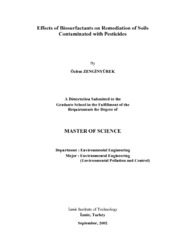Please use this identifier to cite or link to this item:
https://hdl.handle.net/11147/3714| Title: | Effects of Biosurfactants on Remediation of Soils Contaminated With Pesticides |
| Authors: | Zenginyürek, Özlem |
| Advisors: | Ertürk, Handan |
| Publisher: | Izmir Institute of Technology |
| Abstract: | Pesticides have played a significant role in increasing food production, and in view of growing worldwide food demand. Nevertheless; some of them have been classified as persistent toxic chemicals. This has resulted in serious concern about environmental contamination. Once a pesticide or toxic chemical find its way in the environment, a major part of it comes in contact with soil. There are several possible sources of pesticide contamination; at manufacturing, storage, or user sites. The most serious examples of pesticide contamination are typically the result of poor production and waste management practices of pesticide manufacturing, formulation, and application facilities. Improper storage, handling, and also have resulted in pesticide contamination at these sites and at landfills. Today, many remediation technologies are used to remove the pesticides from the soil. One of the soil treatment methods is enhanced biodegradation. Bioremediation of the soil has often proven to be a cheap solution for contaminated soil problem. This research was conducted to investigate the effectiveness of biologically produced surfactants (biosurfactants) on the biodegradation of pesticide-contaminated soil and evaluate the potential for biosurfactant-enhanced bioavailability of pesticide in soil. In order to determine the effectiveness of biosurfactants on pesticides, sophorolipid and rhamnolipid type biosurfactants were used. These biosurfactants were chosen since they are well characterized and their stimulating effect on the biodegradation of hydrophobic substrates was described in the literature. In this study, endosulfan and trifluralin were selected as pesticides. The study was performed in two stages in laboratory conditions. In the first part of the experiment, degradation of endosulfan-contaminated soil was studied by the presence of sophorolipid and in the second part of the experiment; rhamnolipid (JBR 425) was used on the removal of trifluralin-contaminated soil. Throughout the experiment, three different concentrations of sophorolipid and rhamnolipid were applied to soil which, are 0.98, 9.75 and 195 ppm for sophorolipid and 1.6, 100 and 1000 ppm for rhamnolipid. The effectiveness of synthetic or microbial surfactants on biodegradation of chemicals has been investigated by many researchers. However, studies about the biosurfactant enhanced soil remediation for the pesticide contaminants are limited. Besides that, the outcome of surfactant applications has been highly system-specific, conflicting results reported in the literature. Therefore, despite the general trends outlined in literature, the effect of biosurfactants on the biodegradation of organic compounds is poorly understood. Opposed effects are frequently observed. This study is the first M.Sc. thesis study about the use of biosurfactant enhanced bioremediation of pesticides in Turkey. The results from first part of our study obtained from sophorolipid, were not satisfactory since the degradation patterns for endosulfan were not affected by the presence of sophorolipid. According to the second experiment results, removal of trifluralin ranged from 24-35 %, with the increase in rhamnolipid concentrations. Addition of rhamnolipid (JBR 425) into the soil was found to increase the degradation rate of trifluralin by 13 % as compared to the control soil column. Additional time would probably increase the rate of degradation and bioavailability, as a result of providing the adaptation of microorganisms in contaminated soil media and formation of more bioavailable metabolites. |
| Description: | Thesis (Master)--Izmir Institute of Technology, Environmental Engineering, Izmir, 2002 Includes bibliographical references (leaves: 77-81) Text in English;Abstract: Turkish and English 85 leaves |
| URI: | http://hdl.handle.net/11147/3714 |
| Appears in Collections: | Master Degree / Yüksek Lisans Tezleri Sürdürülebilir Yeşil Kampüs Koleksiyonu / Sustainable Green Campus Collection |
Files in This Item:
| File | Description | Size | Format | |
|---|---|---|---|---|
| T000121.pdf | MasterThesis | 736.42 kB | Adobe PDF |  View/Open |
CORE Recommender
Items in GCRIS Repository are protected by copyright, with all rights reserved, unless otherwise indicated.